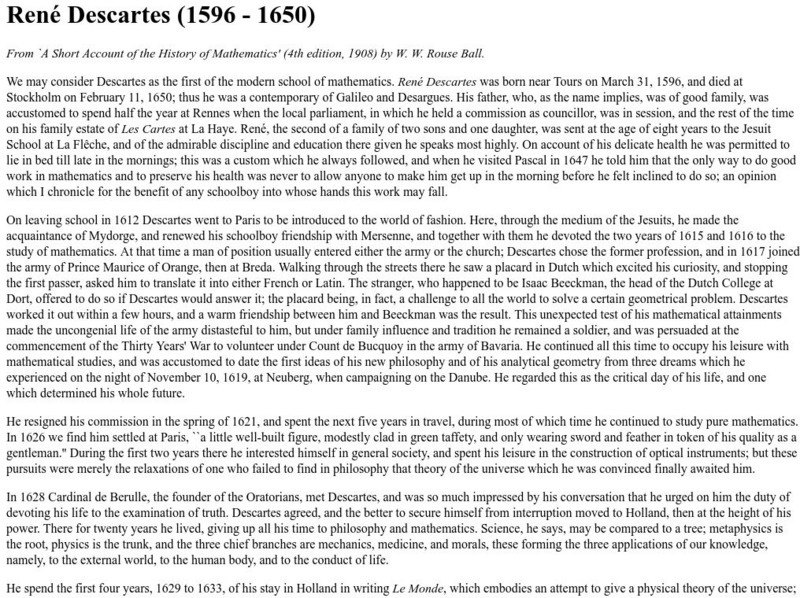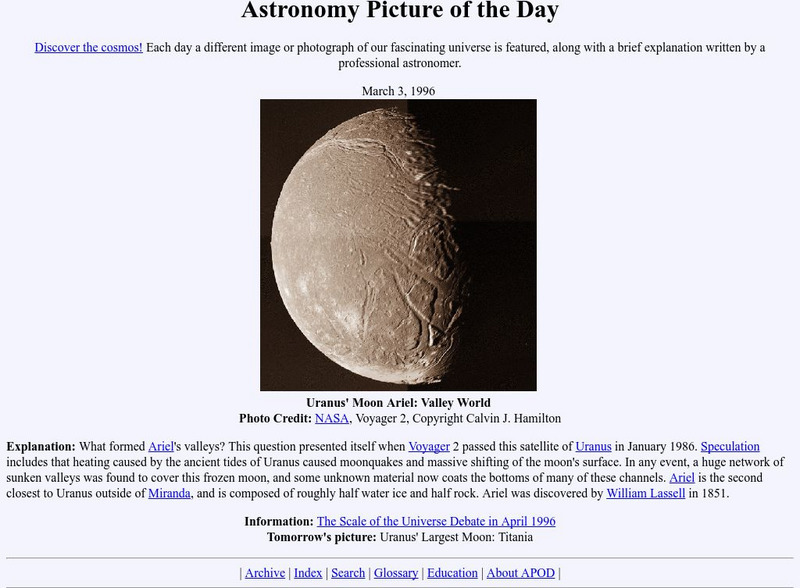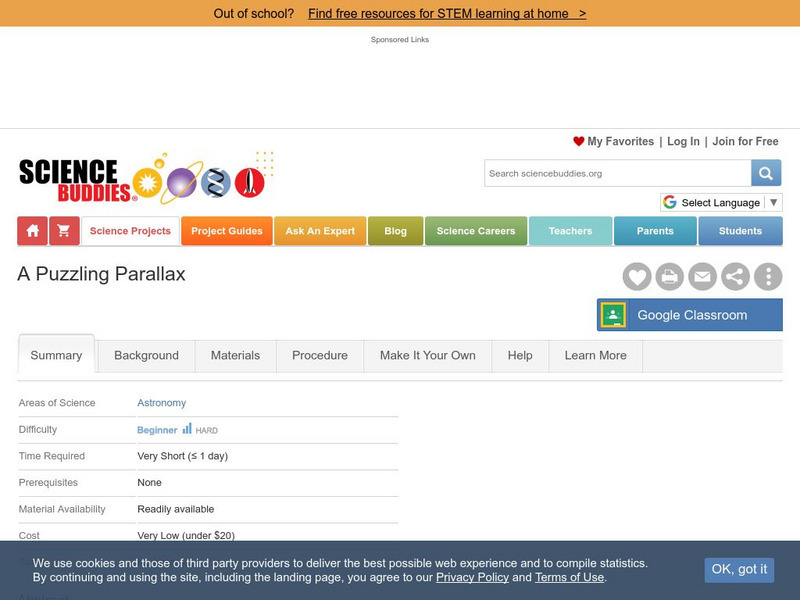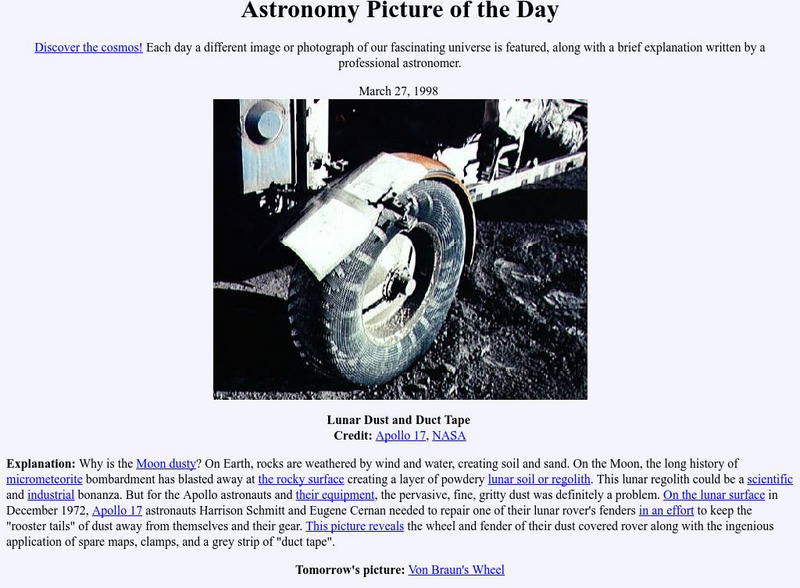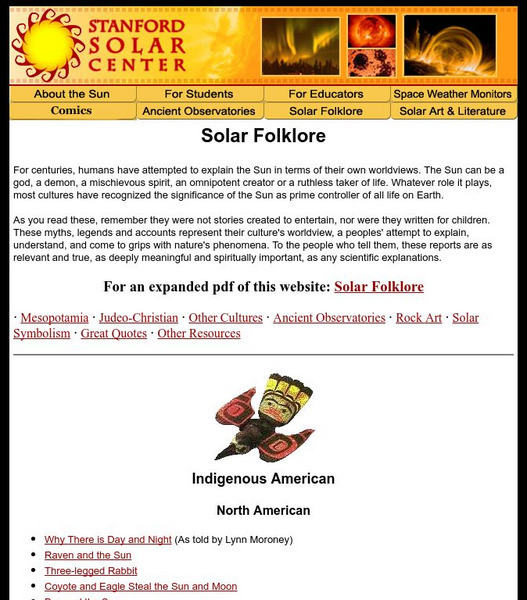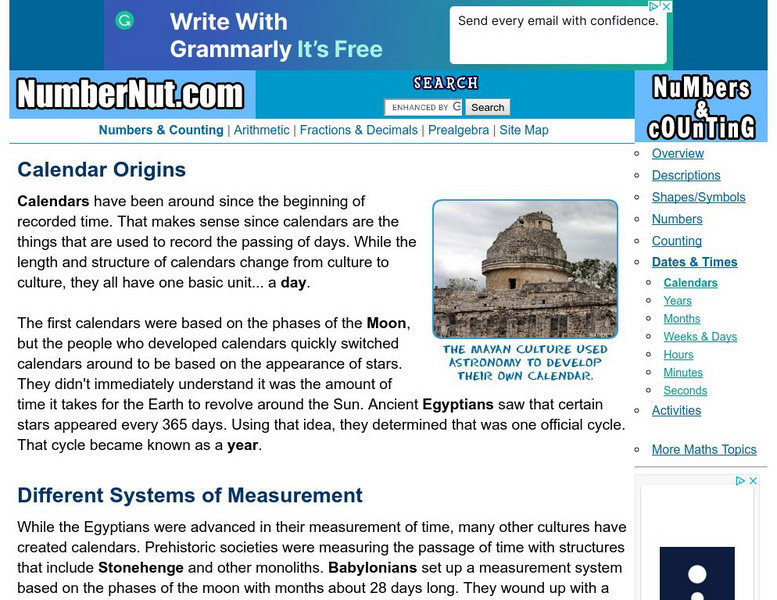Hi, what do you want to do?
Other
Ellinogermaniki Agogi: Eratosthenes Experiment
A profile of the ancient Greek mathematician, geographer, and astronomer, Eratosthenes. Looks at his many accomplishments, including measuring the circumference of the Earth and the distance to the Moon and the Sun. Includes links to...
Trinity College Dublin
Trinity College: Rene Descartes (1596 1650)
Events of Rene Descartes' life are presented in a timeline form. The biographical information is taken from "A Short Account of the History of Mathematics" by W. W. Rouse Ball (4th Edition, 1908).
The History Cat
The History Cat: Islamic Science and Math
Describes the major accomplishments of Islamic civilizations in the fields of Science and Math, i.e., the Islamic calendar, astronomy calculations, windmills, irrigation with gears, and mathematical theories.
NASA
Nasa: Astronomy Picture of the Day: Uranus's Moon Ariel
Provides a brief overview of Ariel, one of Uranus's moons. Details how its deep valleys were formed. A NASA astronomy picture of the day.
Institute and Museum of the History of Science
Museo Galileo: Eudoxus of Cnidos
Not much is known about the life of Eudoxus, a famous Greek mathematician. This is a brief description of what we do know about him.
Other
Lowell Observatory
Lowell Observatory homepage describes the history and current work done at the Lowell Observatory. Contains basic information about the telescopes and the results of work done by staff scientists. It is a national landmark.
Other
Kitt Peak National Observatory
Homepage of Kitt Peak National Observatory (KPNO) which is the one of the premier astronomical observatory used by professional astronomers in the United States. Although the site is mostly geared toward the professional, the Kitt Peak...
American Museum of Natural History
American Museum of Natural History: Ology: Milky Way Galaxy
How big is a billion? Find out some interesting facts about our galaxy, the Milky Way, and its billion stars.
American Museum of Natural History
American Museum of Natural History: What Do You Know About the Universe?
Test your knowledge about the Universe with this quiz.
American Museum of Natural History
American Museum of Natural History: Piloting Red Rover
Do you have what it takes to drives a robot on Mars?
National High Magnetic Field Laboratory
Magnet Academy: Edward Purcell
Edward Mills Purcell was an American physicist who received half of the 1952 Nobel Prize for Physics for his development of a new method of ascertaining the magnetic properties of atomic nuclei. Known as nuclear magnetic resonance...
Science Buddies
Science Buddies: A Puzzling Parallax
Did you know that ancient astronomers could measure the distance to other stars? They could also distinguish between stars and planets. How could they do that without modern technology of telescopes? See if you can discover the link...
Science Buddies
Science Buddies: Which Stars Can You Use for Navigation
A great science project from Science Buddies that examines how ancient peoples navigated without the benefit of a GPS. Find out which stars are important in navigation in the northern and southern hemispheres. The Science Buddies project...
NASA
Nasa: Astronomy Picture of the Day: Lunar Dust and Duct Tape
Dust, a common and usually minor problem on Earth, presented a major challenge for the Apollo astronauts on the Moon. Here's an interesting solution created by the Apollo 17 crew.
Stanford University
Solar Folklore
Folktales from many cultures around the world about the sun. There is also information available about ancient astronomy.
Knowledge Share
Super Kids: Hangman
Use this interactive site to enhance students' spelling and vocabulary while refreshing their memories in history, geography, language, science, and entertainment. It is available to use on line or you can purchase leveled apps for the...
Other
Discover Magazine
Discover Magazine brings you the world of science: the latest research news, enhanced versions of articles, and a full-text archive.
Other
The Astrolabe: Home Page
This site provides a very general overview of astrolabe principles with links to other pages for more detailed information.
NumberNut
Number Nut: Calendar Origins
History and mathematics merge in this lesson that explores the origin of the calendar. Learn how it all got started in this detailed lesson that includes a simple months of the year game and a more challenging time conversion game. Both...
American Museum of Natural History
American Museum of Natural History: O Logy: Stuff to Do: Build the Big Dipper
Illustrated instructions for building a Big Dipper mobile.
Space Telescope Science Institute
Amazing Space: No Escape: The Truth About Black Holes
This site is for teachers or anyone interested in detailed information on black holes. Lesson plans are included as well as a grab bag of web images. Students have a chance to write and submit a paper on black holes and to explore the...
Other
Seds Usa: Charles Messier
Charles Messier (1730-1817 CE) is credited for discovering 13 comets. He also began the Catalog of Nebulae and Star Clusters. This catalog as well as a great deal of information on Messier is available here. The Messier objects are also...
Curated OER
Ancient Greek Philosophy: Thales of Miletus
Includes a short summary of the life and work of the Greek philosopher Thales of Miletus. Discusses his life, work in Astronomy and Mathematics, and view of water and pantheism. Also includes a couple of quotations that make reference to...
TED Talks
Ted: Ted Ed: Music and Creativity in Ancient Greece
You think you love music? You have nothing on the Ancient Greek obsession. Every aspect of Greek life was punctuated by song: history, poetry, theater, sports and even astronomy. In fact, music was so important to Greek philosopher Plato...






